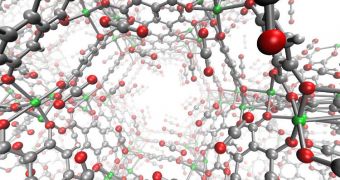A group of investigators from the US Department of Energy's (DOE) Lawrence Berkeley National Laboratory (Berkeley Lab) announces the development of a new computer model, capable of predicting the materials most appropriate for removing greenhouse gases from power planet smokestacks.
Facilities using coal, oil or natural gases to generate electricity release vast volumes of carbon dioxide, molecular nitrogen and many other GHG into the atmosphere daily. Being able to remove the dangerous chemicals from these emissions would significantly improve air quality.
What researchers have been stuck on for a while is finding the best molecular candidates for removing GHG from power plant fumes. With the help of the new model, it will become easier for scientists to investigate the wide array of possibilities, and determine the ones worth investigating further.
Working together with colleagues at the University of California in Berkeley (UCB) and the University of Minnesota (UM), Berkeley Lab scientists developed a model capable of predicting how GHG interact with metal-organic frameworks (MOF), molecular systems known to capture gas efficiently.
Carbon capture and storage (CCS) systems need to be both low-cost and efficient in order to be adopted at a scale large enough to make a difference globally. Several methods of capturing the gas exist, but they are either inefficient, or very expensive.
The new model was developed by UM chemistry professor Laura Gagliardi, and international authority on molecular simulations, Berend Smit. The latter is based at the Berkeley Lab Materials Sciences Division, and is the director of the UCB Energy Frontier Research Center.
“We’ve developed a novel computational methodology that yields accurate force fields – parameters describing the potential energy of a molecular system – to correctly predict the adsorption of carbon dioxide and molecular nitrogen by MOFs with open metal sites,” Smit explains.
“All previous attempts at developing such a methodology failed and most people gave up trying, but our model is applicable to a broad range of systems and can be used to predict properties of open-site MOF that have not yet been synthesized,” the expert goes on to say.
Details of the model appear in a paper entitled “Ab initio carbon capture in open-site metal–organic frameworks,” which is published in the latest issue of the top scientific journal Nature Chemistry.
Support for the study came from the DOE Office of Science, the Center for Gas Separations, the Advanced Research Projects Agency-Energy (ARPA-E), and the Deutsche Forschungsgemeinschaft (German Research Foundation).

 14 DAY TRIAL //
14 DAY TRIAL //